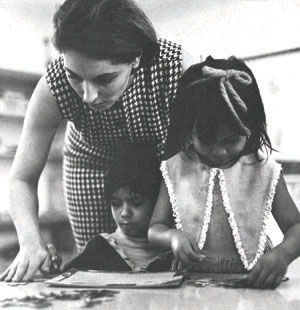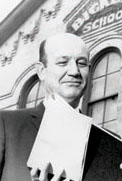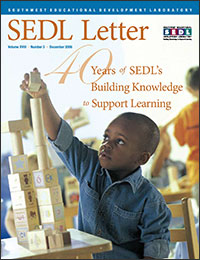The 1960s: SEDL's Formative Years
From the beginning, SEDL's work extended well beyond the bounds of the regional educational laboratory program.
In 1964, President Johnson established an education task force led by John Gardner, who was head of the Carnegie Corporation and later became the Secretary of Health, Education, and Welfare. The task force saw the educational laboratories as a way to improve learning through the dissemination of new ideas and practices. The labs would operate experimental schools, pilot innovative approaches, and provide teacher training.
In a message to Congress in 1965, President Johnson described the laboratories as drawing "equally on educators and the practitioners in all fields of learning . . . to improve curricula and train teachers." A House committee report also envisioned a collaborative, interdisciplinary approach that called for involvement of state departments of education, local school systems, colleges and universities, private research organizations, community organizations and experimental schools. The report reiterated that the laboratories were not to be adjuncts of universities; rather, it called for a new kind of institution that focused on the needs of practitioners.
In 1965, the Office of Education issued guidelines for the new laboratory program, and received 40 formal prospectuses.
Defining the Region and the Work

SEDL's prospectus clearly identified the needs of its region—initially defined as the states of Louisiana and Texas—and articulated a strong mission to address them. Edwin Hindsman, who would become SEDL's first chief executive officer, led a planning committee that also included Rogers L. Barton and James H. Perry, both of whom played important roles in SEDL's history. The committee members proposed a focus on intercultural education, with particular attention paid to low-income Hispanic, African American, and Cajun student populations.
Complex Programs, Multiple Funding Streams
In the first few years of SEDL's existence, Dr. Hindsman oversaw the development of a complex structure of programs that yielded nationally acclaimed curriculum products and research results focused on educationally disadvantaged students. Virtually from the beginning, Dr. Hindsman and his staff looked for additional opportunities beyond the regional laboratory program through which to further SEDL's mission. In fact, in only 1 year—its founding year—did SEDL obtain funds solely from its regional lab contract. Soon SEDL was conducting work under the auspices of other federal agencies, including the Office of Economic Opportunity and the National Science Foundation, as well as state agencies and local school districts.
As the tumultuous 1960s neared their end, five of the 20 labs nationwide closed. The Vietnam War was escalating, creating demands for funding that might have gone to education and other programs. For SEDL, though, the future looked bright. The organization's innovative curricula, which focused heavily on basic literacy, math, and thinking skills for language-minority children, provided the basis for work with migrant students in south Texas. This work included the operation of an early childhood development center in McAllen, Texas, and a "mobile migrant" program in which SEDL staff followed and worked with migrant students as they moved with their families during the growing season. SEDL's curricula work also led to the development of the Follow Through Program, which was designed to extend the benefits of Head Start into the elementary grades and would be critical to SEDL's work for the next 2 decades.
Finally, as the decade closed, SEDL submitted its application for funds to construct an innovative research and development facility that would house the organization. After a site visit by the U.S. Commissioner of Education, the facility grant was approved in August 1969.
Dr. Edwin Hindsman: "Devoted to Finding Ways to Preserve and Develop Human Talent"

Dr. Edwin Hindsman was associate director of the Research and Development Center for Teacher Education at the University of Texas when he chaired the committee that wrote SEDL's original prospectus. He was chosen as the organization's first chief executive officer in 1966 and served until his death on December 27, 1970, at age 47. Under his tenure, the organization grew from five employees to 218. Dr. Hindsman was an educational psychologist who had served on the faculty at the University of Texas and the University of Indiana. He had also been a staff member at the U.S. Office of Education. Preston Kronkosky, who served as CEO of SEDL from 1981 to 1996, described Hindsman as "a visionary and dreamer devoted to children whose lives had been affected by poverty, those who were not being served by the education system." Hindsman believed in tackling the truly difficult problems—the problems no one else was willing or able or brave enough to take on. As the late Congressman Jake Pickle said, "Dr. Hindsman's entire energies were devoted to finding new ways to preserve and develop human talent."
"Serenity does not exist in a state of inaction. It exists for us when we face up to our responsibilities, to our obligations in this changing world."
— Dr. Edwin Hindsman
Rogers L. Barton: Man of Action
If Edwin Hindsman was the visionary who helped define SEDL's mission early on, Rogers L. Barton was the man who put that vision into action. Although Barton never served as SEDL's executive director, he played a large role in the organization's early success. Barton knew how to organize and lead. “He loved good ideas, whether they were his own or someone else’s," said SEDL staff member Martha Boethel, "and he put every idea to the strictest test."
Barton came to SEDL in 1967 from the Texas Education Agency. Preston Kronkosky, who later became CEO of SEDL, had worked previously under Barton in Corpus Christi Independent School District. At the time, Barton was the assistant superintendent of instruction for secondary schools. Kronkosky and Barton overhauled the district’s mathematics program, aligning curriculum district wide. Kronkosky says Barton was devoted to his work and expected others to be as well. "If I was working 12 hours a day, 5 days a week, he asked why I wasn’t working 14 hours a day, 6 days a week," Kronkosky said. "Barton pushed me to grow in ways I hadn’t thought possible."
In 1970 Barton left SEDL for Dallas Independent School District. He later returned to SEDL for a year as a consultant shortly after Kronkosky had been appointed acting executive director. He helped Kronkosky develop a plan for the future of SEDL before his death in early 1984.
Next Article: The 1970s: Scaling Up, Scaling Down

